
Полная версия
The Kitchen Diaries II
The finely desiccated coconut that covered my childhood like snowflakes, on everything from jelly mushrooms to fairy cakes and marshmallows, has never set foot in my adult kitchen. It is a flavour I seem to have left behind, like a school blazer that no longer fits. I keep coconut in two forms: as a can of creamy, brilliant-white milk for soups and curries and as coconut cream, a thicker, more concentrated version made from the top of the milk. This latter form is useful when you want the flavour of the nut without introducing too much liquid. Spiked with ground cumin, cardamom and turmeric, it makes a simple marinade for prawns or chicken. It comes in jars and small cans, like the mixers on the drinks trolley of a plane, and is not to be confused with ‘cream of coconut’ whose principal use is in a rum-spiked piña colada.
Coconut cream is the thick, almost paste-like gloop that rises to the top of the pot when coconut milk is produced. You can make your own by adding water to shredded, fresh coconut, bringing it to the boil and letting it cool. On refrigeration, the cream will rise and can be scooped off.
As well as introducing a nutty sweetness, coconut cream works as a balm. I often add the contents of a small can to knock the edge off an exceptionally spicy lamb curry, or indeed to any dish in which I have misjudged the chilli quotient and left everyone breaking out in a sweat.
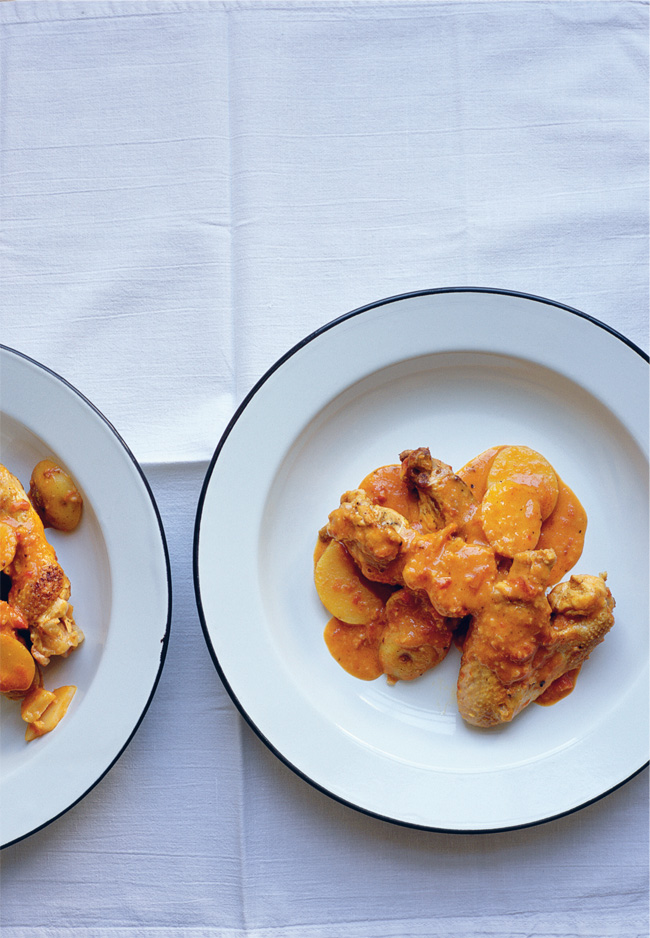
Chicken wings with coconut cream
You could serve this with plenty of the brick-red, coconut-scented sauce and some steamed rice, but I prefer to reduce the sauce over a high heat, stirring almost continuously to prevent it sticking to the pan, till it is thick enough to coat the chicken wings.
groundnut oil: 2 tablespoons
chicken wings: 16 (or 12 large ones)
fresh ginger: a 60g knob
garlic: 2 large cloves
ground chilli: half a teaspoon
ground turmeric: half a teaspoon
ground coriander: a teaspoon
small ‘new’ potatoes: 250g
chopped tomatoes: a 400g can
coconut cream: up to 320ml
coriander leaves: a small handful
Warm the oil in a deep frying pan. Season the chicken wings with salt and pepper, add to the pan and leave them to colour on both sides. Remove to a plate once they are golden brown.
Peel the ginger and garlic and blitz them to a rough pulp in a food processor. Blend in the ground chilli, turmeric and coriander. Cut the potatoes into thin ‘coins’. Return the empty chicken pan to a moderate heat and add the spice mix from the processor. Once it starts to sizzle and its fragrance rises, add the potatoes and 200ml water. Continue cooking, with the occasional stir, for ten minutes or until the potatoes are approaching tenderness. Stir in the tomatoes, bring to the boil and simmer for five minutes.
Pour in the coconut cream (start with 160ml, then add more as you wish). Season with salt, stir well, return the chicken and any juices on the plate to the pan and leave to simmer for fifteen to twenty minutes, allowing time for the liquid to reduce a little. Turn up the heat and, stirring almost continuously, let the sauce bubble till it has thickened considerably. Scrape away at the bottom of the pan with a wooden spoon as you go to stop the sauce sticking. It should be thick and should easily coat the chicken. Stir in a little chopped coriander, if you wish.
Serve in shallow bowls or deep plates and, being best eaten somewhat messily with the hands, provide something for everyone to wipe their fingers with.
Enough for 4
FEBRUARY 28
Hand to mouth
I have always regarded mopping food from my plate with a piece of bread as one of life’s better moments. No doubt it is made twice as enjoyable by the fact I was forbidden from doing it as a child. Those last few puddles of sauce sponged up with anything from a wodge of floury bap to a jagged shard of warm pitta form a natural conclusion to my day’s cooking, a form of delicious closure. Given half the chance, I would be happy to transfer an entire meal from plate to mouth in pieces of warm bread.
Any soft dough, flat or bun-like, can be used to scoop sloppy, spicy or stew-like things from our plates. Yes, the bread adds substance to our supper, but the real point – for me at least – is the tactile pleasure to be had from holding the hot sauce in a piece of damp bread. It feels as good as it tastes. More than just an edible receptacle with which to trap our food, the bread, saturated with juices, becomes part of the dish – more than you can say for a knife and fork.
I sometimes make flatbreads at home, the kind of slipper-shaped breads you can split and stuff, or tear into rough pieces to dunk into taramasalata, puréed chickpeas or chunkily textured tomato sauce. They are perhaps my favourite of all for cleaning my plate. The most straightforward is a flour, yeast and water dough rolled into small ovals and baked. They often leave the oven crisp, so in order to make them soft enough to wipe a plate, I cover the warm breads with a tea towel, which leaves them suitably pliable.
Today I made a sort of gloopy stew with chickpeas and tomatoes, sharpened with pickled lemon, leaving them to cook long enough to make the juices thick and rich. To introduce a bit more depth, I roasted the tomatoes first, tossed around with a chopped ripe pepper and a few cumin seeds, adding a deceptively smoky quality. Just the stuff for a bit of bread.
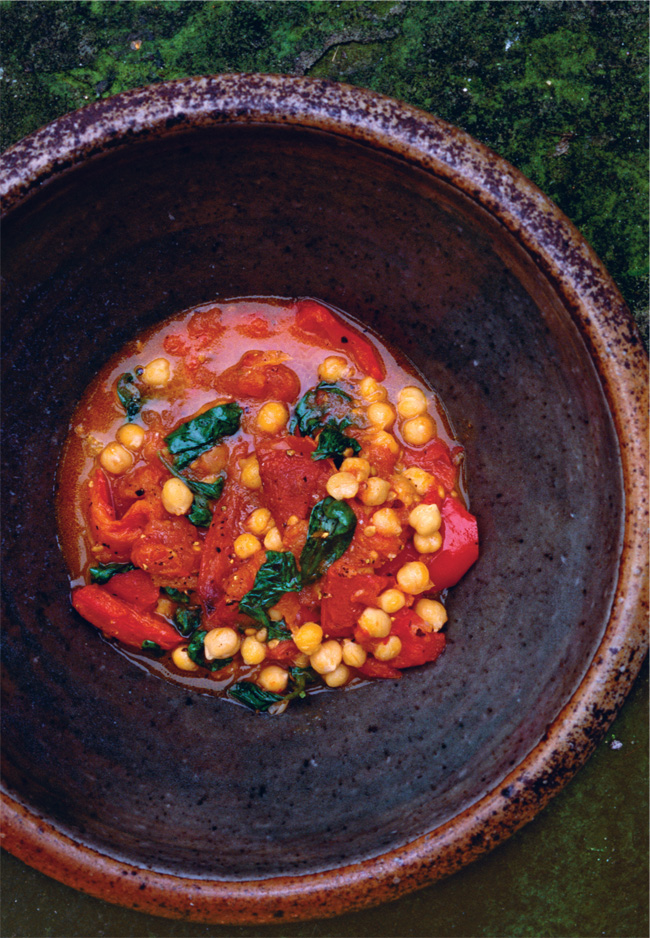
Chickpeas with tomatoes and harissa
A vegetable-based stew to serve with rice or bread.
tomatoes: 800g
red peppers: about 500g
olive oil: 110ml
red wine vinegar: 3 tablespoons
cumin seeds: a teaspoon
chickpeas: two 400g cans
preserved lemons: 60g
harissa paste: a teaspoon
basil leaves: a handful
soft, Middle Eastern-style bread, to serve
Set the oven at 200°C/Gas 6. Remove the tomatoes from their stalks, cut each into six and put them in a baking dish. Cut the peppers in half, tear out their stalks and seeds, cut the flesh into short chunks, then add to the tomatoes.
Add 75ml of the oil, plus the vinegar, cumin seeds and a generous grinding of black pepper and sea salt. Roast for fifty minutes to an hour, until the peppers are tender and the tomatoes are soft and juicy. If the edges have caught slightly, then all to the good.
Transfer the tomatoes and peppers from the baking dish to a saucepan. Drain the chickpeas of their canning liquor and rinse them under the cold tap. Mix the drained chickpeas with the tomatoes and peppers.
Chop the preserved lemon, discarding the soft inner pulp. Stir the harissa, chopped lemon and remaining olive oil into the chickpeas, place the pan over a moderate heat and leave to simmer for ten minutes or so, till it is thoroughly hot and juicy. Season with salt and coarse black pepper.
Fold the basil leaves, whole, into the mixture, letting them wilt in the heat. Transfer to a serving dish and serve with warm bread.
Enough to serve 4, generously, as a main course
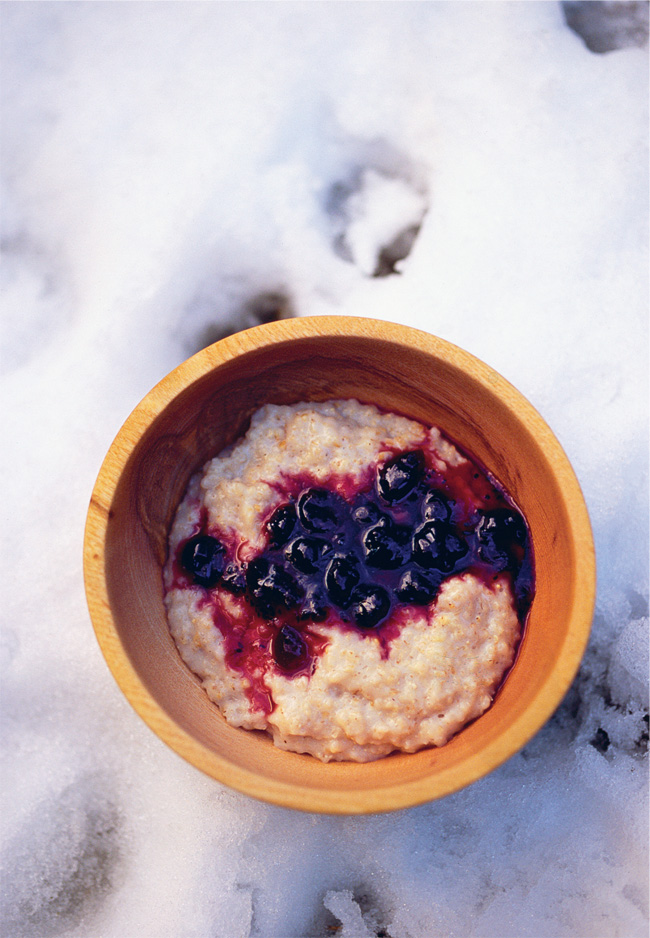
A spurtle, some oats and a beautiful bowl
I have been using my spurtle the wrong way round. This came to light last year, when I took a porridge-making lesson with Ian Bishop in Carrbridge, Scotland. This morning, under a beautiful, grey-white winter sky, Ian’s softly spoken words come back to me.
A spurtle, spirtle, theevil or, as it used to be known in Shetland, gruel-tree, is a thick wooden stick purely for stirring porridge in its pan, and seems like one piece of kit too many, especially to someone with a pathological dislike of unnecessary gadgets. But the gentle sound of warm oats and water being stirred in a thick pan on a freezing morning is a noise of ancient comfort, like the soft crackle of an open fire in an old hearth. I have loved porridge since I was a boy, but my mother made it with milk and sugar whereas I make mine with water and salt.
Ian taught me to use three cups of water to one of pinhead oats. I use the same oats as him now, an organically grown medium oatmeal, and only slightly less salt. He insisted, politely, on a teaspoon of salt to a cup of oats, and I follow his lead, aware that it is almost my entire salt ration for the day. Just as it does in a batch of flapjacks, the salt brings out an almost toasted flavour in the oats. I stir them clockwise only, lest the devil get me, and embellish them with cream and a dark berry jam such as blackcurrant, just as my teacher does.
A bowl of porridge is a quiet breakfast (no snap, crackle or pop) that sets me up for the day. I feel a sense of calm and wellbeing after a breakfast of porridge. I should add that mine now comes in a wooden bowl. I regard my porridge bowls as some of the most beautiful items in my kitchen. They are made by Guy Kerry at his croft in the Black Isle, with ash wood from a tree blown down in a storm.
The recipe is straightforward, and I owe it entirely to Ian. I bring three cups of water to the boil, pour in a cup of medium pinhead oatmeal in a steady flow (let it fall in a steady rain, is how Marian McNeill puts it in The Scots Kitchen), stirring all the time in a clockwise direction. It is done in five minutes, no longer, a scant teaspoon of salt added in the last minute of cooking. As it slides into the wooden porridge bowls, I spoon in a smudge of damson or blackcurrant jam and, if there is any around, some cold single or double cream, avoiding the temptation to write my initials with maple syrup. Tradition prefers us to stand. I hope that leaning against the kitchen sink isn’t going to induce the wrath of the devil.
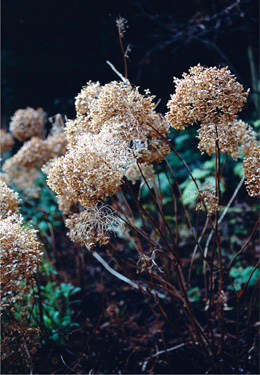
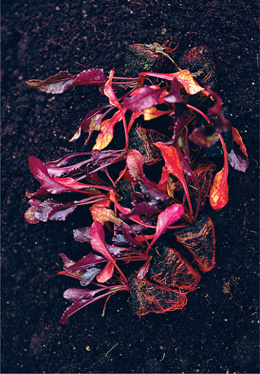
March
MARCH 2
The cast-iron casserole
A casserole is a cooking vessel rather than the food cooked in it. Nevertheless, the word has come to mean a thick, sloppy stew cooked in a covered pot. I’m no pedant and that is fine by me. Once under the ownership of the frugal home cook, such recipes are now standard gastropub fare, and in particular those involving lamb shanks.
The shank, no longer the cheapest of meats, is the hard-working cut from the top of the front leg. The muscles and sinews of the shank can soften or tighten as the mood takes them, so it is best cooked slowly, in liquid, and in a low oven. Frustratingly, the flesh can fall easily from the bone or not, so exact timing in a recipe is almost impossible. They may need an hour or three. Of course, modern cooks demand a recipe that is done in the time it states, but with the lamb shank we must enter a different mindset, one where something is done when it feels like it, not when a recipe says it should be.
Size isn’t necessarily an issue, but the smaller the shank, the quicker it may come to tenderness. No guarantees though; I have met the odd tough little bugger before now. Covering with a lid or foil will help the meat to steam as well as bake, which should encourage it down the path towards tenderness. But the most likely way to guarantee your meat falling from the bone in a sinewy, velvety mound is to sink it in plenty of liquid – stock, wine, cider, whatever. Just keep the meat covered. This is no mean feat with a large shank, so regular turning during cooking is essential to keep as much of the flesh covered for as long as possible.
I have several casseroles – by which I mean the pots, not their edible contents. A couple are scarred from bean-based recipes forgotten in the oven (chickpeas leave bubblewrap-type rings on the base; cannellini the sort of snow you get on an untuned television screen), whilst many have cream or grey linings that have taken on the hue of red wine sauce. That’ll be boeuf bourguignon, or perhaps oxtail. There is a beautifully understated matt-black one, solid cast iron, which I use for stock and occasionally for a breadcrumb-topped stew. If I were a different sort of cook, it would have been used like those in Castelnaudary, the French home of cassoulet, with its bits of pork, goose and beans. But mine gets used for macaroni cheese, chicken casserole with tarragon and potatoes and, today, a heart-warming dish of lamb shanks cooked with thyme, garlic, onions and black-eyed beans, or other beans if you wish. The sort of recipe that looks as if it took days to make, that warms like no other and makes you feel like a real cook. Whatever one of those may be.
Lamb shanks with black-eyed beans
I say black-eyed beans, but you could use haricot beans or chickpeas if that is what you have to hand.
dried black-eyed beans: 500g
bay leaves: 2
olive oil
lamb shanks: 4
onions: 3
thyme: 4 small sprigs
garlic: 4 plump cloves, finely sliced
plain flour: 4 lightly heaped tablespoons
stock or, at a push, water: 750ml
For the crust:
fresh white breadcrumbs: 150g
a handful of chopped parsley
olive oil
Soak the beans in cold water overnight to plump them up. The next day, drain and rinse them, then bring to the boil in deep water, together with the bay leaves and a good glug of olive oil. Boil hard for ten minutes, then reduce the heat so they simmer merrily till they are just tender yet retain their shape and some bite – a matter of thirty to thirty-five minutes or so. Drain the beans in a colander and set aside.
Season the lamb shanks and lightly colour them in a little oil – 2 tablespoons should do – in a heavy-based casserole. Once they are pale gold, remove them, but leave their cooking fat behind. Peel the onions, cut them in half and then cut each half into thick segments. Let these soften in the pan over a medium heat, adding a little more oil if there is less than a couple of spoonfuls of fat left. As the onions soften, add the thyme sprigs and the garlic. When all is soft and translucent, stir in the flour and leave to colour lightly for two or three minutes. Gradually stir in the stock to make a thick, oniony sauce. Set the oven at 180°C/Gas 4.
Tip the drained cooked beans in with the onions, then tuck in the lamb and any juices from the plate and season with salt and black pepper. Simmer for thirty minutes, partially covered with a lid, stirring from time to time to check the beans are not sticking. Add more stock if you feel it needs it, then remove from the heat.
Mix the breadcrumbs and parsley with 3 or 4 tablespoons of olive oil, then scatter them over the top of the casserole. Cover loosely with foil, transfer to the oven and cook for an hour and a half or until the meat can be persuaded to part company from its bones. Remove the foil and cook for a further ten to fifteen minutes to let the crust crisp up.
Enough for 4
Getting passion fruit right
The passion fruit offers us the crunch of a hundred seeds, a dab of golden jelly surrounding each one and a little (very little) piercing saffron juice. Sour, sweet, soft, crisp, the passion fruit gives us a hit of bracing freshness to brighten a grey day.
The dark, spherical fruit is most usually sold unripe – that is, completely smooth, a dull purple mauve, either in packs of four from the supermarket or loose in a cardboard box from the greengrocer’s. Keep them till the skin has thinned and its surface is covered with dimples, like a golf ball. Like us, the passion fruit is better for a few wrinkles.
As your fruits progress towards ripeness, their skin will shrivel and become a little brittle. Though small, they should feel heavy for their size. Lightness is generally an indication of dryness within. Catch it before the casing collapses on one side, which is the fruit’s last gasp.
Eaten too early, the passion fruit has an astringency that will remind you of the pomegranate, and the juice will be watery and pale. Kept till ripe, it will give you intense fruit flavours and bright, clean, fresh-tasting juice and seeds, to be eaten first thing on a cold morning, with a teaspoon, like a boiled egg. A little cup of sunshine.
This morning the greengrocer has a box of them that are spot on (I have a feeling they were about to be thrown out). I get them cheap and use their knife-sharp juice to make tiny pots of golden cream no bigger than espresso cups. Just four or five teaspoons per person with which to end tonight’s dinner.
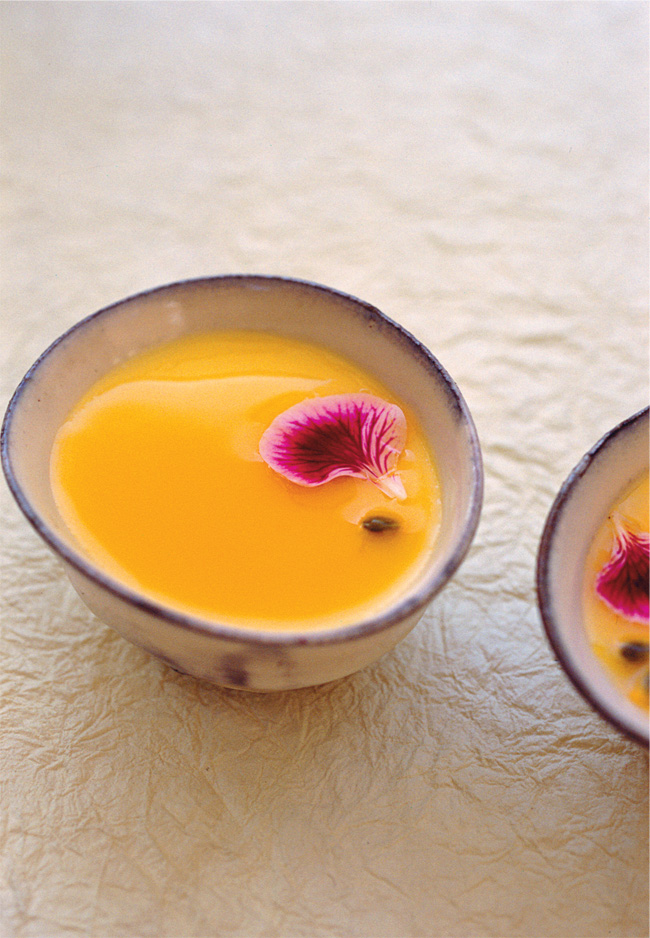
Passion fruit creams
passion fruit: 16
double cream: 500ml
caster sugar: 150g
lemon juice: 35ml
Cut the passion fruit in half and scrape out the seeds and juice into a small sieve balanced over a measuring jug or bowl. Let the juice from the fruit drip through, then rub the seeds against the sieve with a teaspoon to get as much of the pulp through as you can. Set the juice aside in a cool place and reserve the seeds for later.
Put the cream and caster sugar in a saucepan and bring to the boil, stirring occasionally to dissolve the sugar. Lower the heat and leave to bubble for three minutes, stirring from time to time. Put the lemon juice in a measuring jug and make the quantity up to 75ml with the reserved passion fruit juice. Keep the remaining juice cold.
Remove the cream mixture from the heat, stir in the lemon and passion fruit juice and leave to settle for a few minutes. Pour into 6 or 8 espresso cups or very small glasses. I like to stir a few of the reserved passion fruit seeds into the mixture for a contrast in texture (say, half a dozen per cup) but that is up to you. Cool, then refrigerate for at least a couple of hours.
Just before you serve the creams, spoon a little puddle of the passion fruit juice over the top. As each diner digs in with their teaspoon, the juice will trickle down into the depths of the cream.
Makes 6–8 espresso cups
MARCH 6
Beans on toast again
Being compiled from my dog-eared, chaotic notebooks rather than a meticulously kept and chronologically perfect diary means that many of my everyday meals, those I tend to do almost on autopilot, rarely get their fifteen minutes in the limelight. This is a shame because they are often jolly good eating.
Such meals tend to get taken for granted, like very close friends. One of my favourite quick fixes has always been beans on toast. I like the sweet commercial sauce and the thick toast, which, just for the record, I always butter. The joy of richly sauced beans and hot toast is not confined to the turquoise tin though, and I often make a home-made version, with cans of beans that I put in my own sauce, stirring in bacon, mushrooms or whatever is to hand (chorizo and black pudding are favourite additions).
Today, even with my woolly hat on (I now have three, and every one of them makes me look as stupid as the other), the biting-cold wind is making my ears numb. The idea of going home to sweet, sticky beans with a wodge of warm sourdough bread appeals more than almost anything I can think of. I could cop out with my mate Heinz, embellishing them with chilli or Marmite, or even a bit of bacon, but instead decide to take an extra thirty minutes to make a down-home version. It does the trick.
Beans on toast
A little more trouble than opening a can, but much more satisfying when you have the time.
lardons or cubed bacon or pancetta: 200g
an onion
a little rapeseed or olive oil
a rib of celery
carrots: 2 small to medium
chopped tomatoes: two 400g cans
canned beans (pinto, haricot, butter beans etc): two 400g cans
black treacle: 1 teaspoon
a lump of sourdough loaf
Fry the lardons in a deep pan over a moderate heat. Peel and roughly chop the onion. When the lardons and their fat are golden, add the onion, together with a little rapeseed or olive oil if there seems too little fat in the pan. Chop the celery and carrots, add to the pan and leave to cook for a full five minutes, till fragrant and starting to soften. Add the tomatoes, simmer for ten minutes, then stir in the drained beans and simmer for another ten minutes. Season with the treacle, a little black pepper and some salt.
Warm the bread in the oven, tear into chunks and serve with the beans.
Enough for 2
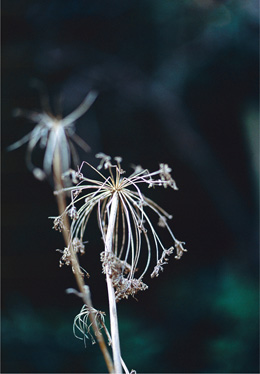
MARCH 7
A tropical marinade and a shoal of sea bass
For some time now I have been curious about glass, and why some is more beautiful to look at, and look through, than others. Windows made from old ‘crown’ glass have soft waves and little bubbles, like tiny seeds to catch the light, while drinking glasses that are uneven in the hand, with ripples and furrows, make the water within sparkle. Small things, but they matter to me. I like drinking water from a hand-made tumbler with dimples and folds.
Aesthetics aside, glass is a useful object in the kitchen because it has a neutral effect on the food we put in it. Unlike aluminium, glass is unaffected by acid ingredients such as rhubarb, lemon and vinegar. Leave a batch of poached rhubarb in a glass bowl and it will taste the same after a night or two in the fridge. Use aluminium and your fruit will have taken on an unpleasant taint from the dish. It is one of the reasons glass has been used for centuries for storing acid-based preserves such as pickles and relishes.
I also use glass to marinate meat and fish. Not only is it non-reactive but you can see the changes taking place in the food more easily. Make a ceviche in a glass dish and you can see whether the fish has turned opaque from the lime juice. I can’t be the only person who finds measuring liquid in a glass jug more accurate than in one made from china. I particularly like making the classic lemon surprise pudding in a Pyrex bowl so I can see the distinct layers of sponge and lemon sauce.
Today I work on a recipe for a television programme for next Christmas (such is the life of a cookery writer). It is not my recipe, but comes via The Rebel Dining Society. It’s fresh, clean, smart and uses up the rest of the passion fruit.
A ceviche of sea bass and passion fruit
passion fruit: 4
limes: 2
an orange
a vanilla pod
sea bass fillets: 4
a red chilli
a small yellow or orange chilli
chives: 4 or 5, snipped into short pieces
coriander leaves: a small handful
Squeeze the juice of the passion fruit, seeds and all, plus the limes and the orange into a bowl. Scrape in the seeds of the vanilla pod and mix gently.









